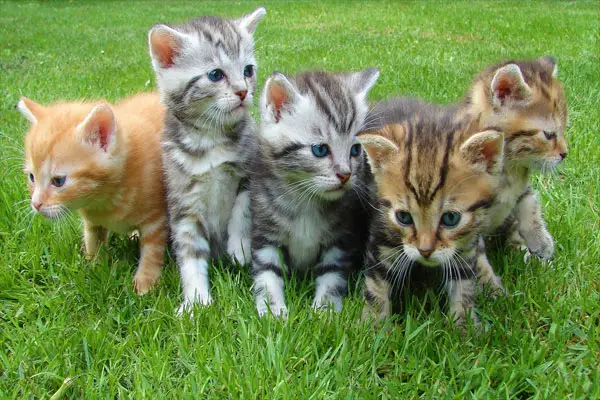Can Cats See Infrared: The Truth About Their Vision
- By Infoik
- 14 Oct, 2021

Do you ever wonder if your cat can see infrared? It’s a question that has puzzled pet owners for years. Can cats see in the dark? Can they see things we can’t? Today, we will answer all of your questions about cat vision! We will discuss how cats see infrared, what colors they can see, and how well they can see in different light conditions. So, read on to learn everything you need to know about your cat’s vision!
Can Cats See Infrared: The Truth About Their Vision
Cats have better peripheral and night vision than humans, but their lack of depth perception makes them easy targets for predators.

Cats also depend on keen smelling skills to hunt prey with such low-resistance heating equipment as well as an inferior sense of smell compared to us (even though we’re not sure if this is true). However, they compensate for these flaws by having excellent tracker sight that allows cats up close or afar detection depending on what’s needed at any given moment!
Some animals can see things that humans can’t. We’ll talk about some of the ways these unusual sighted creatures survive and how their incredible eyesight helps them get through life in this article, but first, let’s take a look at all those fantastic features! Some nocturnal species have better night vision than others. For instance, owls or cats with color vision will be much more sensitive when it comes time for hunting prey on nights, while during the daytime, colors don’t matter as much because there is plenty else going around.”
Can Cats See Infrared Lights?

Infrared rays are invisible to humans, but cats can see them. How is this possible?
Inner-ears on a cat’s head detect sounds farther away than the human ear because they have better hearing in low light conditions and at higher frequencies (IRC). In addition, their fur coat insulates against heat loss like an insulation blanket would do for you when it gets cold outside. As a result, these kitties may be able to spot prey who is hiding among snowdrifts or under leaves!
Why Cats Can’t See Infrared Lights
Cats are warm-blooded mammals, and it’s more difficult for them to see infrared light because that would cause their body heat or temperature fluctuations to create interference. But, on the other hand, if cats could have this ability, they might get confused by all the different colors around us!

Overexposure with these lights can hurt how our eyes work–by baking up inside of themselves too much due to specific cells being heated beyond what they are used to in some cases (like ours).
Cats are masters at finding the warmest spots in any room, no matter how dark it is. This Thermal Detection ability has its roots deep into what makes cats so adorably unique and acute vision! As an animal without color night sight like humans can have, they rely on their sense of temperature more than anything else for navigation through life’s many challenges- including hunting prey that isn’t always easy to spot by eye alone.
This Is How Cats See the World
It’s not every day you come across an artist who can paint a perfect picture of what life with your eyes closed would be like. Yet, this is precisely what Nickolay Lamm has done by painting pictures for cats, considering all aspects and input from veterinarians and ophthalmologists!
A unique insight into our furry friends that we may never really realize was there until now, seeing as most people only know them through human perception or sitcoms such as “Cats.”
Which animal can detect infrared rays?
The best examples of animals that can detect infrared light are a group of snakes called pit vipers. Rattlesnakes, copperheads, and other members in this genus like to eat birds with dark feathers or small warm-blooded prey such as rats because these creatures typically have higher body heat than their surroundings do – which makes them easier for predators who want access into your home without being detected by its usual sensors (the human nose).
Do dogs have infrared vision?

Dogs excel at the smell and can see in a way that humans cannot. They have an extraordinary sense of smell, but what about their vision? The truth is we don’t know; however, it seems like they may be able to sense infrared with other senses such as taste or touch!
Which animal can detect infrared waves?

Infrared light has longer wavelengths and lower energy than visible light, which can’t be seen with our human eyes. But mosquitoes use the infra-red spectrum for vision! Some vampire bats also hunt in this region of electromagnetic radiation; bed bugs do too when they need to find their prey by thermal detection instead of sight because it’s much better at penetrating surfaces/materials that block normal heat sensation like metal walls or floors covered with carpeting (which could conceal blood).
Is UV light damaging?

UV exposure is a significant risk factor for the development and progression of potentially blinding eye diseases. If you’re not wearing sunscreen, your unprotected eyes may suffer irreversible damage that could lead to serious medical issues, including cancer!
Over time, it has been shown how excessive UV radiation can affect our health in many ways, such as increasing risks associated with skin cancers (the most common type).
Can dogs see in total darkness?

As much as we humans love to lay in bed and watch TV after dark, dogs can see just fine when there’s no light around. The secret of their superior night vision is due to the large amount rods found within our retinas that collect any available rays from bright sources like streetlights or cars on roads at night – something only a few animals possess!
Can dogs see infrared?

Dogs can use their sense of smell in ways that humans cannot. Their nose is so acute it can detect the tiniest hints of danger, like when an impending thunderstorm approaches or if you burn someone’s fingers on the kitchen stovetop.
Dogs also have an exceptional vision; they’re not as good at seeing infra-red light (which would be invisible), but I think we all know what our pup Memphis does best: sniffs out every single fire risk before needing us. Too!
Are colored lights bad for cats?
Some people worry about the effects of LED lights on their pets, but there’s no need to fret. LEDs are just as safe and healthy for animals as other types of lighting currently available in stores!
Can cats sense cameras?
A cat’s personality can be either very entertaining or tiresome. Some people love cats while others cannot stand them, but when you get one that seems like it is modeling for your camera every time, these are the only two options!
Does red light affect cats?
Red lights for cats and humans alike can help enhance the results of consistent use. Most felines enjoy the warmth, so chances are red light therapy will be comforting to them too! It’s not just about their comfort – it also applies to more than just feline companions: this treatment has been found effective with many different types of pets such as dogs or even turtles who need some extra attention from time to time.
Are our LED Strip Lights bad for pets?
One of the most popular types of lighting for homes is LED strip lights. Dogs can safely use these with few consequences. Still, there are some precautions to consider, like making sure there aren’t any trailing cables and looking out for signs that your dog may experience distress from flickering light; however, these fixtures still work well even if you don’t. Want them in every corner!
What animals can see infrared?
Snakes are noted for their exceptional infrared vision, which some people say is the sixth sense. Blood-sucking insects also rely on this ability to feed themselves and other creatures in much the same way that snakes do with their bodies’ heat sensors — or what biologists call “thermoception.” Fish have been found capable of seeing far into Red Light Absorption Chromatic Visibility Spectral Instrumentation Night Vision InfraRed Perception Purple Region UV Receptor Pupidae) invisible wavelengths only seen by frogs when they’re leucistic – possess white patches instead of pregnancy sex chromosome pairs).
Can dogs see UV light?
UV light may be invisible to humans, but it doesn’t mean that cats can’t see in UV. A study reports on the ability of several mammals species, including dogs and other animals who have an ultraviolet vision too! Knowing this could provide insight into their behavior because it will help explain what they do when you previously didn’t know about these abilities.
Do LED lights bother cats?
Technology in your home may be affecting the health of cats and dogs. Devices, including TVs, DVRs, and LED lights that are now commonplace for living rooms, could cause problems with pets inside who might not like playing around them or being blocked by something while trying to view their favorite show on TV.
Is UV light safe for pets?
UV is incredibly safe and effective as a disinfectant for four rooms and items when used correctly. When used correctly, however, it can cause injury to human vision and dog vision. So you don’t want to use it while you’re in the room, and you don’t want to use it while pets are present.
What colors are soothing to cats?
Choose your colors carefully to make sure both cats and dogs can see what you’re drawing. Use blues, greens, purples – anything in the visible spectrum because these colors will appear bright on their eyes!
Is UV light harmful to dogs?
UV rays are only harmful to our four-legged friends who already have an eye disease or are prone to allergies. These mainly include pathologies that affect the cornea, such as pannus, including “Dry Eye,” tumors, and cataracts.
Are cats’ eyes sensitive to light?
To protect themselves from the sun, cats have a particular layer of tissue called tapetum lucidum. This helps them see better than humans and can withstand more light!
This passage talks about how cats’ eyes are so sensitive to a brightness that they may need eye exams once or twice yearly, just like people do.
Can dogs see infrared light?
Infrared light is invisible to the human eye, but it’s a necessary form of heat radiation for creatures like dogs. Dogs can sense this type of warmth because they have special receptors in their noses that detect infrared signals from other animals or people nearby!
Does red light bother cats?
Cats love warmth, so red light therapy for cats is likely to be comforting. In addition, dogs see a more limited color range than humans, and they’re not visually sensitive in the same way that people are; this means that their sensitivity level isn’t as high- making them less susceptible to using near ranges of infrared or reds like many other creatures would be.
Conclusion:
Cats have a much better sense of infrared than we do, which helps them see in the dark and stalk prey. While they can’t see all the colors that we can, their world is still full of beautiful sights. So the next time you’re out at night and spot a kitty watching you from the shadows, know that they see things in a way that you never could.
Read another Cat related blog here









